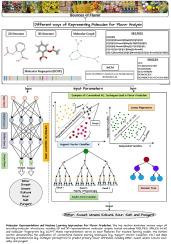A survey of machine learning techniques in flavor prediction and analysis
IF 15.4
1区 农林科学
Q1 FOOD SCIENCE & TECHNOLOGY
引用次数: 0
Abstract
Background
Flavor prediction—the computational estimation of a compound's sensory profile from volatile and non-volatile compounds—is increasingly important for innovation in food, beverage, fragrance, and pharmaceutical industries. Traditional methods such as Gas Chromatography–Mass Spectrometry (GC–MS) and sensory evaluation remain valuable but face limitations in scalability, subjectivity, and cost. Taste perception, mediated by receptor–ligand interactions, fundamentally shapes the multisensory experience of flavor.
Scope and approach
This review examines diverse machine learning (ML) and deep learning (DL) approaches applied in flavor prediction, benchmarking their performance across sweet, bitter, umami/kokumi, pungency, and multi-class taste predictors. It spans traditional ML algorithms (SVM, RF, KNN) and advanced DL models (CNNs, RNNs, GANs, and LLMs), with additional focus on hybrid and ensemble strategies. A particular emphasis is placed on molecular representation (SMILES, SELFIES, fingerprints), the integration of multi-omics data (genomics, proteomics, and metabolomics) for a holistic understanding of flavor formation, genotype–phenotype–flavor relationships, and the crucial role of taste receptor information for enhancing model interpretability.
Key findings and conclusions
Model performance varies by taste modality: gradient boosting and consensus models excel for sweetness, SVMs and Graph Neural Networks (GNNs) for bitterness, and CNN + GNN hybrids for multi-class classification. Kokumi and umami benefit from GNN embeddings, iUmami-SCM, and transformer-based models with experimental validation, while pungency prediction—(though underexplored)-shows promise with ensembles and quantum chemistry-informed features. Challenges remain, including limited high-quality datasets, underfitting on novel molecules, and the interpretability gap in deep learning. Advances such as SELFIES and receptor–ligand–aware models (e.g., BitterX, BitterTranslate, KokumiPD) address these issues by ensuring structural validity and enhancing mechanistic insights.
Significance and novelty
The review identifies future directions in explainable AI, IoT-enabled data collection, multi-omics fusion, molecular representations, and hybrid modeling—offering a roadmap for scalable, interpretable flavor prediction in next-generation food, fragrance, and pharmaceutical innovation.

风味预测与分析中的机器学习技术综述
风味预测——从挥发性和非挥发性化合物中对化合物的感官特征进行计算估计——对食品、饮料、香料和制药行业的创新越来越重要。气相色谱-质谱(GC-MS)和感官评价等传统方法仍然有价值,但在可扩展性、主观性和成本方面存在局限性。味觉,介导受体与配体的相互作用,从根本上塑造了多感官体验的味道。本综述研究了不同的机器学习(ML)和深度学习(DL)方法在味道预测中的应用,对它们在甜、苦、鲜味/味、辛辣和多类味道预测中的性能进行了基准测试。它涵盖了传统的机器学习算法(SVM、RF、KNN)和高级深度学习模型(cnn、rnn、gan和llm),并特别关注混合和集成策略。特别强调的是分子表征(smile,自拍,指纹),多组学数据的整合(基因组学,蛋白质组学和代谢组学),以全面了解风味形成,基因型-表型-风味关系,以及味觉受体信息在增强模型可解释性方面的关键作用。主要发现和结论模型的性能因口味形态而异:梯度增强和共识模型在甜味方面表现突出,支持向量机和图神经网络(GNN)在苦味方面表现突出,CNN + GNN混合模型在多类别分类方面表现突出。Kokumi和umami受益于GNN嵌入、iUmami-SCM和基于变压器的模型,并得到了实验验证,而pungency预测(尽管尚未得到充分探索)显示出具有集成和量子化学信息特征的前景。挑战仍然存在,包括有限的高质量数据集,对新分子的拟合不足,以及深度学习的可解释性差距。诸如自拍照和受体配体感知模型(例如,BitterX, BitterTranslate, KokumiPD)通过确保结构有效性和增强机制洞察力来解决这些问题。该综述确定了可解释的人工智能、支持物联网的数据收集、多组学融合、分子表征和混合建模的未来方向,为下一代食品、香料和制药创新中可扩展、可解释的风味预测提供了路线图。
本文章由计算机程序翻译,如有差异,请以英文原文为准。
求助全文
约1分钟内获得全文
求助全文
来源期刊

Trends in Food Science & Technology
工程技术-食品科技
CiteScore
32.50
自引率
2.60%
发文量
322
审稿时长
37 days
期刊介绍:
Trends in Food Science & Technology is a prestigious international journal that specializes in peer-reviewed articles covering the latest advancements in technology, food science, and human nutrition. It serves as a bridge between specialized primary journals and general trade magazines, providing readable and scientifically rigorous reviews and commentaries on current research developments and their potential applications in the food industry.
Unlike traditional journals, Trends in Food Science & Technology does not publish original research papers. Instead, it focuses on critical and comprehensive reviews to offer valuable insights for professionals in the field. By bringing together cutting-edge research and industry applications, this journal plays a vital role in disseminating knowledge and facilitating advancements in the food science and technology sector.
 求助内容:
求助内容: 应助结果提醒方式:
应助结果提醒方式:


